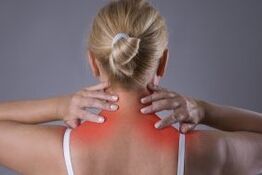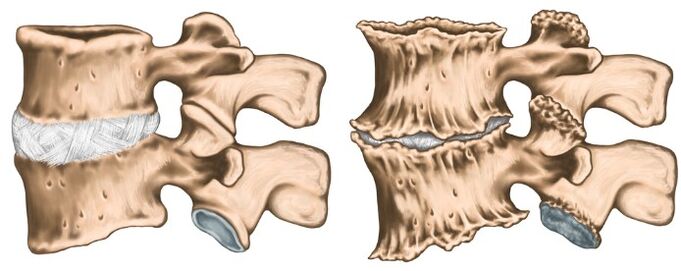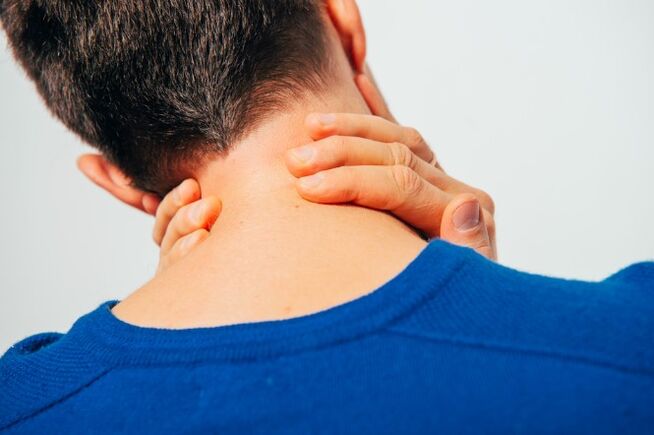With the osteochondrose of the spinal column, many are known not from the popular gears from the TV screen, but from its own sad experience.Statistics are sharp: up to 80% of the population suffers from this disease, which is also significantly younger.If the previous complaints on the problems in the spine were mostly among the older generation, now children's osteochondrose no longer surprises anyone.And the guilt of a seated lifestyle and thus-wereked "advantages of civilization."

Osteochondrosis of the spine of cervix is a polyethological progressive disease that is manifested by degeneration of intervertebral disks and the dystrophy of the ligamental spine apparatus.Everyone knows the symptoms first hand, but these knowledge are fragmentary;We will try to structure them, as well as discuss the principles of diagnosis and treatment of osteochondrose of the cervical spine.
Causes of osteochondrose
Medical science cannot an unequivocal response, which is why osteochondrose appears.It is reliable to know that a sitting way of life that is a modern person prone to negatively affect the advancement of this disease.It is interesting that both hypodynamics and colossal loads of athletes lead to proxy disks.The hereditary factor plays a leading role.The following reasons differ:
- burdened hereditary history;
- obesity;
- hypodynamia;
- Metabolic disorders in the body;
- Traumatic damage to the spinal column;
- Long static overload and operation associated with lifting difficulties (computer operation, weight lifting, miners, drivers, etc.);
- Scoliosis;
- Non-functional environmental situation;
- Flat feet and pregnancy;
- Hypothermia and stress, which often cause a deterioration of the disease.
There are several neurological syndromes:
- Periaritis shoulders
- root;
- cardiac;
- Vail Artery syndrome.
Periarthritis on the shoulder.It is characterized by the pain in the neck, shoulder, shoulder joint.The leading neurogenic arms of shoulder in nature is formed, as it protects axillary nerve from stretching (an anti-pose).With this position, the muscles surrounding the wrist are tension.The weight of the pain syndrome depends on the degree of deterioration of osteochondrose: on a slight restriction of the amplitude movement in the joints on such a "frozen shoulder", when any movements cause serious pain.The pain is intensified when shoulders are redirected and uttered, because these movements that improve the tension of an axillary nerve.

Royshift syndrome (cervical radiculite).It usually occurs with cervical osteochondrose.At the same time, the spine of the spinal nerve is compressed by "judging" intervertebral disks, as well as due to the growth of osteophytes or disk protrusions in the sideline.Cheese pain is specific: Intensive ignition, tearing, pressing pain, which also boosts when the patient moves his head.An antelgic pose is also noted in neck muscles, they are sharply tense and painful, the amount of movement is limited.There is a pain in the back of the head, neck, front chest, shoulders, between the blades.Sensitivity disorder by type "Semi-jacket with short sleeves" is characteristic.
Cardian syndrome.The name of syndrome is responsible for yourself: the clinical picture is very similar and angina pectoris.In this case, there is no organic damage to the heart, at the height of pain syndrome, the violation of the coronary flow of blood ECGs are not revealed, and such patients are well tolerated.A typical feature with angina pectoris: pain takes place after taking nitrates, and in case of osteochondrone does not change and bothered long time.Unlike angina pectoris, the localization of pain is mainly in the heart on the left.With the irritation of the roots of the Segments of C8 - T1, rhythm disorders in the form of tachycardia and extrasoles are possible.This does not exist due to the damage to the heart conduct system, but with a violation of the cute mismatching of the heart muscle (extracardiard damage).In the differential diagnosis of angina pectoris and heart syndrome, the leading fact that the patient notices an increase in shoulder pain and neck related to lifting or sharp motions.
Vail Artery syndrome.The vertebral artery takes place in the channel that formed holes in the transverse processes of vertebral.This artery is paired, is responsible for the brain blood supply.Accordingly, every narrowing of this channel is very negatively affected by brain tissue nutrition.The syndrome of the vertebrate artery is also developing directly with the compression of the artery itself and with the irritation of the sympathetic nerve plexus located around it.Pain in this pathology is worse or pulsates in the occipital area with expanding on whiskey, bows of textbooks, crows.Occurs on both of both sides.Patients usually associate the deterioration with the state of sleep in non-syllabic loan, trips to traffic, walking.With pronounced symptoms, hearing loss, dizziness, ear, nausea, vomiting, loss of consciousness and increase blood pressure.Such symptoms are not specific and are very similar to the appeals in stroke.This pathology is characterized by the syndrome of the Sinth Chapel: the unconsciousness that occurs when you roll over your head back (heavy brain ischemia).Visitors described him in the Sicinean Chapel in the Vatican when they examined the frescoes in her arches.It is possible to fall without losing consciousness with sharp conversion of the head.
Like any diagnosis in medicine, osteochondrosis diagnosis has been established on the basis of patient complaints, anamnesis of diseases, clinical examinations and auxiliary research methods.The X -Ray of the cervical spine in direct and side projections is performed, if necessary in special positions (with open mouth).At the same time, experts are interested in the amount of intervertebral disks, the presence of osteophytes.Modern research methods, IAmr and CT research are used, which enables the most common diagnosis to check.In addition to the mentioned methods of additional research, consultations of related experts (cardiologist, ophthalmologist, neurosurgeon) may be required, and neurologist examination is simply vital.Neurologist deals with osteochondrose treatment, and after the patient interrogation, the minimum review is required at its discretion.

Healing osteochondrose
Osteochondrosis is a polyethological disease, because one course therapy does not heal.You can't drink "magical tablet" and everything will pass, you need to change your lifestyle basically, because it's a hypodynami trigger.The most tangible results are easier to achieve in the initial phase of the disease, when complaints are minimal and there is no compression syndrome and the spinal artery.In the acute phase of the disease, when the following groups of drugs prescribed with pain were prescribed: Bol syndrome pronounced:
- Therapeutic blockade paravertebral (for relief of pain and removal of muscle spasm);
- Nsaids;
- Fats containing NSAIDs and reflex actions;
- muscular relaxants;
- B Vitamins V.
As the inflammatory process also collapses and facilitate pain syndrome, transition to the treatment of physiotherapy.The following techniques are most often used:
- Laser therapy;
- electrophoresis;
- acupuncture;
- Exercise therapy;
- Therapeutic massage;
- Hand therapy.
It is important to understand that Osteochondrosis continues with periods of deterioration and remission, so it is very important to influence the cause, not to treat the investigation.































